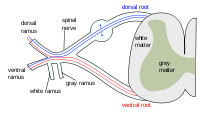
Photo from wikipedia
Serotonin (5-HT) is known to act via multiple 5-HT receptors at spinal and supraspinal levels to regulate micturition. However, the contribution of peripheral 5-HT and its receptors in bladder physiology… Click to show full abstract
Serotonin (5-HT) is known to act via multiple 5-HT receptors at spinal and supraspinal levels to regulate micturition. However, the contribution of peripheral 5-HT and its receptors in bladder physiology and pathology is not very well understood, despite evidence showing expression of multiple 5-HT receptors in the bladder wall and 5-HT may activate bladder afferent nerves. The current study was designed to investigate the possible role of 5-HT4R in modulation of the sensitivity of bladder afferents to bladder filling. Immunofluorescent staining showed abundant 5-HT4R immunoreactivity largely confined to the uroepithelium in wild type (WT) but not 5-HT4R−/− mice. In the ex vivo bladder-pelvic nerve preparation, intravesical application of the 5-HT4R agonist RS67333 (1–30 μm) caused concentration-dependent decreases of the pelvic nerve response to bladder filling. Such effect was not observed in the presence of 5-HT4R antagonist GR125487 or in 5-HT4R−/− preparations. A cohort of 5-HT4R−/− and WT control mice were treated with intraperitoneal injections of cyclophosphamide (CYP) (75 mg/kg, three times at 2 days interval) to induce chronic cystitis. Void spot analysis showed that CYP-treated 5-HT4R−/− mice urinated more frequently than their CYP-treated WT counterparts. Concomitantly, bladder afferents of CYP-treated 5-HT4R−/− mice displayed exaggerated sensitivity to bladder filling in comparison with the CYP-treated WT controls. These data suggest that 5-HT4R expressed on uroepithelial cells plays an inhibitory role in mechanosensory transduction in the bladder. Loss of 5-HT4R-mediated inhibition may enhance bladder afferent sensitivity and exacerbate bladder overactivity in pathological conditions. We propose that 5-HT4R agonists might be exploited for the treatment of overactive and painful bladder symptoms.
Journal Title: Frontiers in Physiology
Year Published: 2022
Link to full text (if available)
Share on Social Media: Sign Up to like & get
recommendations!